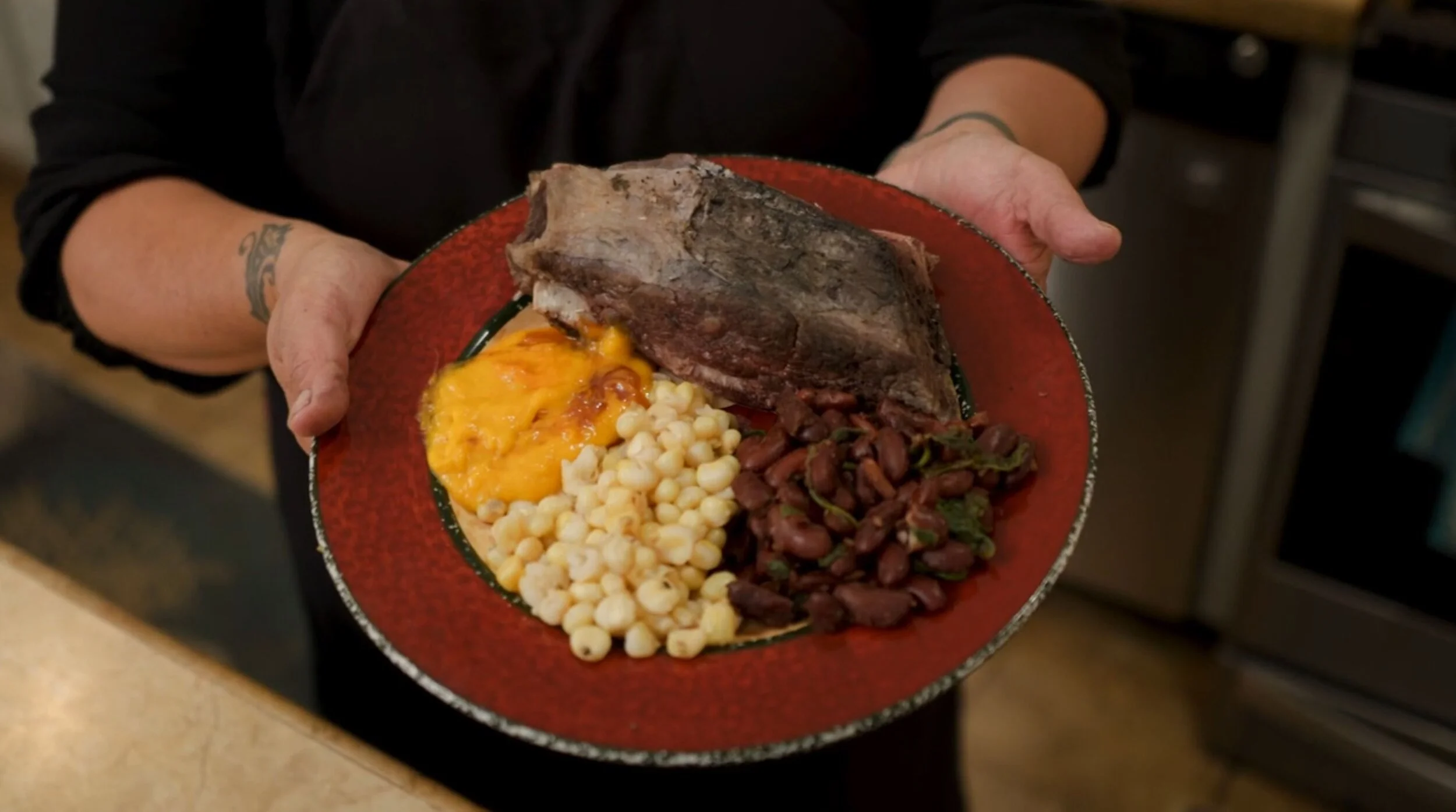Braised bison ribs, squash custard, and red beans.
The ingredients used by Chef Addelina Lucero (Taos Pueblo/Yaqui) in this recipe are the result of relationships with people and places both near and far away. Some, such as the wild plants described below, cannot be obtained without understanding what they are and where they grow, while others, like corn and squash, are the results of millennia of stewarding the same plants in the same place, year after year. When preparing this recipe, consider where the ingredients originate from and how they arrived in your kitchen.
Ingredient Spotlight:
Wild Spinach
Wild spinach, also known as Lamb’s Quarters or chiquelites, are only distantly related to domesticated spinach (both are members of the Amaranth family). Wild Spinach is widespread across much of the world. If you have a garden, it’s likely that you’ve encountered wild spinach as a “weed,” growing in dry and disturbed areas. Like many weeds, this durable and hardy plant has incredible nutritional value, high in fiber, protein, Vitamins A and C, omega-3 and 6 fatty acids, and many important trace minerals. It does contain some oxalic acid, so it is best eaten raw in small quantities, though cooking it, like Chef Lucero does in this recipe, neutralizes the acid. When prepared this way, it tastes similar to chard.
Wild Mint
Nearly every plant in the square-stemmed Mint family, Lamiaceae, is edible in one way or another. The wild mint used in this recipe, Field Mint, is widespread and easy to identify a member of this family. Field mint resides alongside creeks, rivers, or wetlands, where its robust rhizomes (part of the roots) help anchor banks and prevent erosion. Other than the square stem, one way to identify mint is by the smell, a luscious fragrance that’s hard to describe but very easy to recognize. Once you do, you will often notice it as you walk through a creekside brush, a sure sign that mint is somewhere nearby.
Wild Celery
Wild celery is part of a family that isn’t quite so friendly as Mint. Apiaceae, the Carrot or Parsley family, contains many useful or edible plants, including dill, fennel, coriander, sweet cicely, and the eponymous carrots and parsley. Additionally, it also includes hemlock, a source of potentially deadly confusion for anyone pursuing one of its edible relatives. Many carrot species look alike, especially when flowering, so if you plan to harvest members of this species, be very careful or, better yet, go with someone who knows what they are doing.
Fortunately, the habitat of wild celery mentioned here doesn’t have significant overlap with the more dangerous members of the family. It grows in open fields and hills in the Southwestern United States, with small, succulent fern-like leaves. Both the leaves and the tuberous roots are edible. Phellopterus Montanus, Phellopterus bulbosus, and Cymopterus bulbosus refer to the plants known as “wild celery.”
Recipe
For Brine
5 sprigs Cedar (or Juniper) branches
5 sprigs Wild mint
5 sprigs Wild Celery
1 Pinch Cayenne Pepper
1 cup Salt per gallon of water
Enough water to completely submerge ribs.
For Beans
.5 lbs Red Beans
4 sprigs Wild Celery leaves.
For Ribs
4 lbs Bison Ribs
20-25 Corn husks
¼ cup Maple syrup
For Corn
.5 lbs dry white corn posole or hominy
For Squash Custard
2 winter squash (such as acorn or butternut)
1 can organic unsweetened coconut milk
Dash of cinnamon
Dash of Maple syrup
Wild plum syrup, to taste
Create Brining tea
Combine cedar, wild mint, wild celery, and cayenne pepper. Mix with water. Place ribs in tea and brine for at least a couple of hours, or overnight.
Prepare Charcoal Pit
While the ribs brine, light a fire in a “cook pit” using hardwood logs. Continue feeding it until you have built up a sufficient amount of coals (see video).
Begin Beans
Place beans in water. Bring to a boil. Lower temperature to medium heat and simmer for 1.5 or until beans are tender.
Prepare Corn
Place dried white corn or hominy in a pressure cooker. Cook at pressure for 3-4 hours, until kernels are tender and have “popped.” If not using a pressure cooker, pre-soak and boil on the stovetop until tender.
Prepare Ribs
Soak corn husks in water. Lay aluminum foil on a sheet pan or other preparation area. Once corn husks are pliable, lay on aluminum foil in thick, overlapping layers. Place brined bison on corn husks, drizzle with maple syrup. Season with salt. Wrap foil in a nice tight package so that no steam can escape. Add additional foil as necessary to seal completely.
Cook Ribs.
Dig out charcoal, ensure that no flames or wood remain. Place ribs in the bottom of the cooking pit, and re-cover with charcoal. Cover charcoal with dirt. Allow the ribs to cook in the pit for roughly 1.5 hrs.
Make Squash Custard.
While ribs are cooking, steam squash until tender. Allow to cool. Remove the pulp and place in a separate bowl. Add coconut milk, cinnamon, and maple syrup. Add wild plum syrup, to taste.
Finish beans
Over low heat, stir in wild spinach. Allow to cook down slightly. Salt to taste.
Plate
Combine ribs, posole, red beans, and squash custard on a plate. Serve and enjoy.


